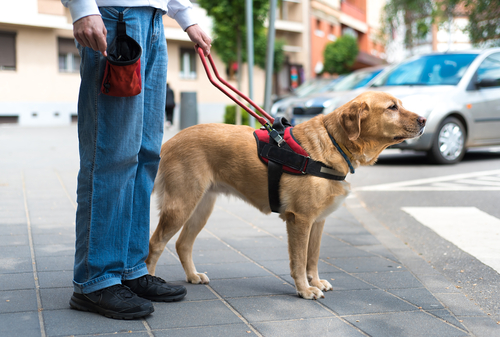For many people, service dogs are not only helpful, they are as valued and beloved as any other member of the family. You may have worked hard to ensure that your service dog is perfectly well-behaved in any situation imaginable, however, it’s still important to keep a few things in mind when traveling with your little helper. Here are a few tips for traveling with service dogs (and other service animals):
Learn the TSA guidelines first
Before anything else, you should head to the TSA website and thoroughly read all of the TSA guidelines for traveling with service dogs. Unsurprisingly, you are required to inform a TSA agent if you are traveling with a service dog; you and the animal will both be screened with a metal detector. You will be able to go through the metal detector with your dog; should you refuse to, both you and the dog will be screened via a pat-down.
Naturally, any items that your dog requires, such as collars, leashes, and toys, are also subject to screening. The rules may differ depending on where exactly you are traveling, as well. For example, if you are entering another country, they may have specific rules pertaining to the animals that enter the country. Some places require all animals to be quarantined for a period after entering the country; this is for the safety of the people and the local ecosystem.

Check your airline’s guidelines
While the TSA rules will be the same no matter what airline you are traveling on, individual airlines have their own rules that you will be expected to follow. It’s a good idea to get in touch with whichever airline you are flying with and let them know you are traveling with a service animal. They can inform you of any guidelines specific to their airlines and also make the proper preparations for you and your service animal to travel.
Take steps to make it easier on your animal
Traveling with service dogs can be just as stressful for animals as it is for humans. There are a few things you can do to lessen the toll that a long trip will take on your service animal. Start by trying to book a direct flight, if possible. The more connections that you have to worry about, the more stress it will put you and your animal through.
When you arrive at the airport, take your animal to one of the spots specifically designated for animals to relieve themselves. After they have done so, limit their access to water until the trip has concluded. This will help avoid your animal sitting in discomfort during the course of the flight. Make sure your service dog gets plenty of exercise prior to the flight as well; this will help to prevent it from feeling cooped up, and a dog that is tired from an exercise session is more easily kept under control.
Make sure you cooperate with security
When traveling with service dogs, communication with all levels of security is key. Begin by informing security that your animal is not a pet; once they are aware it’s a service animal they will generally move you to the front of the queue because your security screening will generally take longer as the animal needs to be screened as well.
As having access to your service animal may be crucial to you, security should never need to separate you from your helper. While they are required not to separate you from your animal, if you pass through security ahead of your dog, you will not be able to go back to it until after it, too, has been screened.
Certain airports have specific requirements for traveling with animals. Do not allow yourself to become frustrated if it takes a while to go through security. Make sure you are always cooperative with all security personnel. If, after you have gone through security, you discover that your service dog needs to relieve itself again, you may have to exit the secure area and go all the way through security again. Ensure you communicate with security so they are aware of everything you need to do.
Always have proper documentation
When you are traveling, you always have to have your own documentation, such as a passport or other government issued ID, with you. If you are traveling with a service dog, the same rules apply. You must make sure you always have the proper paperwork for the animal with you at all times. Although it is highly illegal to do so, people do attempt to sneak pets through security by pretending that they are service animals. As a result, you will have to be able to provide proof that your animal is indeed really a service animal and not simply a pet. You may have to include a letter from your physician, explaining what tasks your service dog is trained to perform.
Service animals perform a wide variety of tasks, ranging from seeing eye dogs for the blind to dogs that provide psychiatric help for their owners. Service animals are also not limited to dogs; there are many different types of animals that provide a variety of services. For example, miniature ponies are becoming increasingly popular as service animals for the blind, while pigs, which are highly empathetic and compassionate animals, are commonly seen as therapy animals at airports across the country.
Make sure your service dog is well behaved
While your service dog (or other animals) may be the sweetest, most well-trained animal in the world most of the time, some animals are still prone to anxiety when traveling. Traveling is a highly stressful situation for animals, and you may need to take additional measures to ensure that your animal remains calm through the process of boarding a plane and traveling long distances. It’s certainly possible you won’t actually need your service dog while you are flying; in which case you can make special arrangements to have the animal transported separately from you. This will generally be easier for the dog or other service animals.



